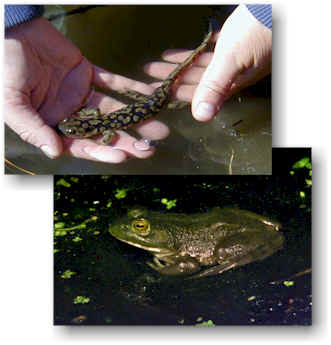Amphibians

BNL is home to fourteen species of amphibians. The Fowler's toad (Bufo fowleri), Eastern spadefoot toad Scaphiopus holbrookii holbrookii), and Eastern tiger salamander (Ambystoma tigrinum tigrinum) were the only amphibians found in uplands and only in pitch pine/oak habitats. Fowler's toads and tiger salamanders are common onsite, as evidenced by the numbers of aquatic larvae of each species observed.
Easter Tiger Salamander
(Ambystoma tigrinum tigrinum) (New York State-listed endangered species)
Our largest salamander at 5 7/8 - 9 ¾" (15 - 35 cm) long. Highly irregular splotches olive to yellow color on black dorsum. Very plump, with 12-13 costal grooves. Similar to the spotted salamander (A. maculatum), however, adult tiger salamanders are significantly larger, as are metamorphs.
This species is listed as "Endangered" by the New York State Department of Environmental Conservation. It is fairly common at BNL but is uncommon or extirpated throughout many of the other parts of L.I. Fossorial. Live in heavily forested areas with moist to dry soils in scattered populations throughout our area. Seldom seen, except during breeding. They live under logs and rocks and also underground in rodent and self made burrows. This is the largest salamander in the eastern U.S. Breeding occurs January to April. Gelatinous egg masses are attached to submerged vegetation. Larvae hatch during summer at about ½". They transform into adults when they reach about 4-7". Females lay 205-328 eggs deposited in 5-8 egg masses. Average mass is 41 eggs.


